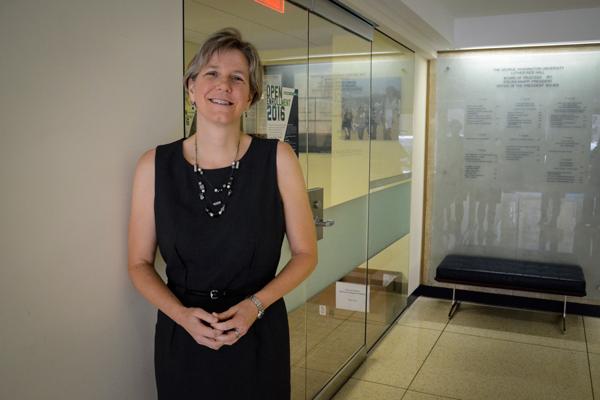Officials have added a new position in the enrollment office to make sure more students graduate from GW.
Interim Provost Forrest Maltzman said earlier this month that he is searching for a director of retention to keep students at GW and make sure they graduate within six years. Laurie Koehler, the vice provost for enrollment management and retention, said creating the position will ensure that officials continue to focus on not only bringing students but making sure they stay and graduate on time.
GW’s freshman retention rate – the number of freshmen who return to campus for their sophomore years – has hovered around 93 percent over the last five years. That number is significantly higher than the national average and similar to peer institutions, like New York and Boston universities.
Koehler said faculty, staff and students from across the University are involved in the search process for the new position, but she declined to say who exactly. She said the office plans to hire the director this summer.
“Our goal is to increase the likelihood that as many of our students as possible have positive experiences at and graduate from GW,” she said.
She said staff in the office are collecting information from students to identify how to best measure “institutional progress” on student retention. Koehler said the new director will “provide strategic direction and support.”
Koehler said the enrollment office has reallocated resources in recent months to focus more on student retention and graduation to make sure that “we have the staff designated to focus on this goal.”
“The role of the enrollment management and retention office is not to replicate the excellent work already being performed by others,” Koehler said in an email. “Essentially, everyone at the University shares the responsibility for retaining and graduating students.”
Earlier this academic year, the Office of Enrollment Management and Retention expanded to include student retention as part of its title and primary responsibilities, and officials hired a specialist to examine how to improve retention strategies.
University President Steven Knapp said last fall he planned to focus on boosting GW’s retention and graduation rates.
Southern Methodist University is the only one of GW’s peer institutions that includes a director of retention in the provost’s office. Other peer institutions, like the University of Miami and Emory University, have retention centers within student affairs offices.
Experts said there are a variety of reasons why students choose to leave a university, including financial burden, poor academic performance or a feeling of not fitting in on campus.
Ed Venit, the senior director of the Education Advisory Board – a consulting firm that works with universities to improve performance – said hiring a high-level retention administrator is a growing trend nationally.
He said adding a director of retention to the provost’s office “creates a quarterback” within the administration – someone who will visibly lead the effort.
“In general for anything if you have an owner of it then someone is taking responsibility,” he said. “Traditionally, student success has been owned by everyone and therefore owned by no one. But what we see for schools that are making big leads is they are assigning a leader high up in administration that owns the issue.”
He said many institutions would “love to be where GW is” in retention and graduation rates but added that if the University is going to compare itself to its peers, “of course they want to do better.”
Noel Radomski, the director of the Wisconsin Center for the Advancement of Postsecondary Education, said bringing in an administrator to focus solely on retention would be a good step in keeping more students on campus but only if that person works closely with the provost, deans and other staff across University offices.
“You need to have the provost to have authority to reach down to lower-level departments and offices,” he said. “You have to have that authority to change things so you can really impact the entire campus community.”








